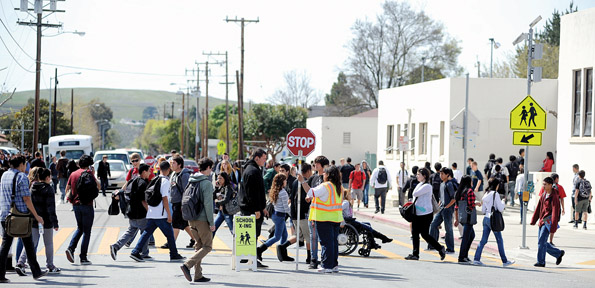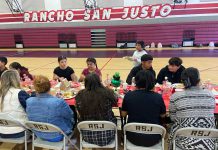Trustee Rodriguez presents concerns about intersection to county board of supervisors
Trustee Rodriguez presents concerns about intersection to county board of supervisors
San Benito High School Trustee Ray Rodriguez brought attention to the snarl of traffic around the high school before and after school at the Tuesday county board meeting.
Rodriguez brought the issue to the board with concerns for student safety as they cross Nash Road near Monterey and West Streets throughout the day. Using information from a 2007 traffic study at the high school, Rodriguez said more than 11,000 trips are made across Nash Road between the main campus, which is north of Nash Road, and the portion known as the new campus that is on the south side and spans east toward San Benito Street.
“You may say the study is really old, but nothing has changed and studies cost tens of thousands of dollars,” Rodriguez said.
He cited the study that said a “temporary or permanent closure may be required to maintain safe passage.” Rodriguez said school leaders were not asking the county to close Nash Road during the school day, but they would be happy with that solution. He said they would be content to work with the city and county to put up stop signs at both corners to
Rodriguez said the study found that students are on campus 42 weeks out of the year. Based on traffic numbers for August compared to September, the study preparers estimated that about 7 percent of drivers reroute to avoid the high school traffic when school is in session. He said that the completion of the Hwy. 25 bypass does not seem to have lessened the amount of traffic in the area.
“That doesn’t include foot traffic on weeknights,” Rodriguez said of the 11,000 trips. “You have little kids darting out in the street and cars going 45 miles an hour.”
The speed limit on Nash Road is posted as 35 mph, with 25 mph through the school zone. Rodriguez said he believes cars regularly exceed that speed limit.
Rodriguez said one of the issues on Monterey and West streets is that when parents drop off students, they don’t want to go south on the roadways and get stuck at the intersections with the crossing guards. He said he has seen parents stop on the other side of the roadway and make students cross to the campus. He also has watched drivers make dangerous three-point turns that back up traffic, he said.
“An all-the-way stop would be great,” Rodriguez said. “For law enforcement, it is easier to enforce illegal stops than speeding.”
A CHP commander for Hollister-Gilroy who was at the morning meeting said enforcement can be a hard way to make changes, but that structural changes could help change the behavior.
Allen Stallman, who talked about a collaborative partnership with local law enforcement in school zones during April, said the CHP would be willing to support improving traffic near San Benito High School.
Rodriguez expressed concern that the school board had brought the issue to county supervisors, city council members and the Council of San Benito Governments in the past with no resolution to the issue.
“What are your excuses going to be?” he said.
Each county supervisor pledged support of working with the high school to install stop signs. Steve Wittry, of the county public works department, said he would add the item onto the agenda for a meeting with the high school later in the day.
He said a stop sign costs about $1,000 for installation, but it would be necessary to work with the sheriff’s office and the Hollister Police Department to make the signs enforceable.
“I see no problem with stop signs,” said Supervisor Jerry Muenzer. “I know there are issues with a closure (of Nash Road between Monterey and West streets.) I don’t think the infrastructure would support that.”
Pat Loe, a former supervisor, spoke during the public comment period. She said that at the time when the addition to San Benito was being built, there was no traffic impact study done.
“Fifteen years ago before the new campus was built, a group of citizens asked them not to move forward without a traffic study,” Loe said. “Their justification was that it would be a totally closed campus on the south side. It was to be a freshmen campus, and it would not increase traffic because there would be mandatory bussing.”
Loe said after the campus was completed, there was an outcry against bussing and keeping freshmen separate from the rest of the student population.
“At the time it was done was the time to address it,” Loe said. “Now to come back and put it on the county and city is unfair. The high school has to be at the table.”
Loe encouraged the school trustees and the board to look at long-term solutions for the traffic issue.
“What is our most precious resource?” Rodriguez said to supervisors. “Is it canned tomatoes or our students?”
He referenced the closure of roadways near the cannery. He also noted that Watsonville allows for road closures during school hours near its high school.
“This is the third time we’ve been through this,” he said. “I need you to take a personal stand to send a message to COG and the city that this is the right thing to do.”
get drivers to stop while people are crossing the road.
Principal Krystal Lomanto said while there are crossing guards at the intersections to guide pedestrians across the roadway, she said she has seen drivers curse at students and flip them off on a daily basis.
“The students are passionate about this issue,” Lomanto said. “I could bring 2,000 of them to the board meeting. Everyone can tell you a story about ‘that close.’”
Lomanto thanked the supervisors for their support.
“The students should be our No. 1 priority,” she said. “It is also about keeping our staff safe.”










